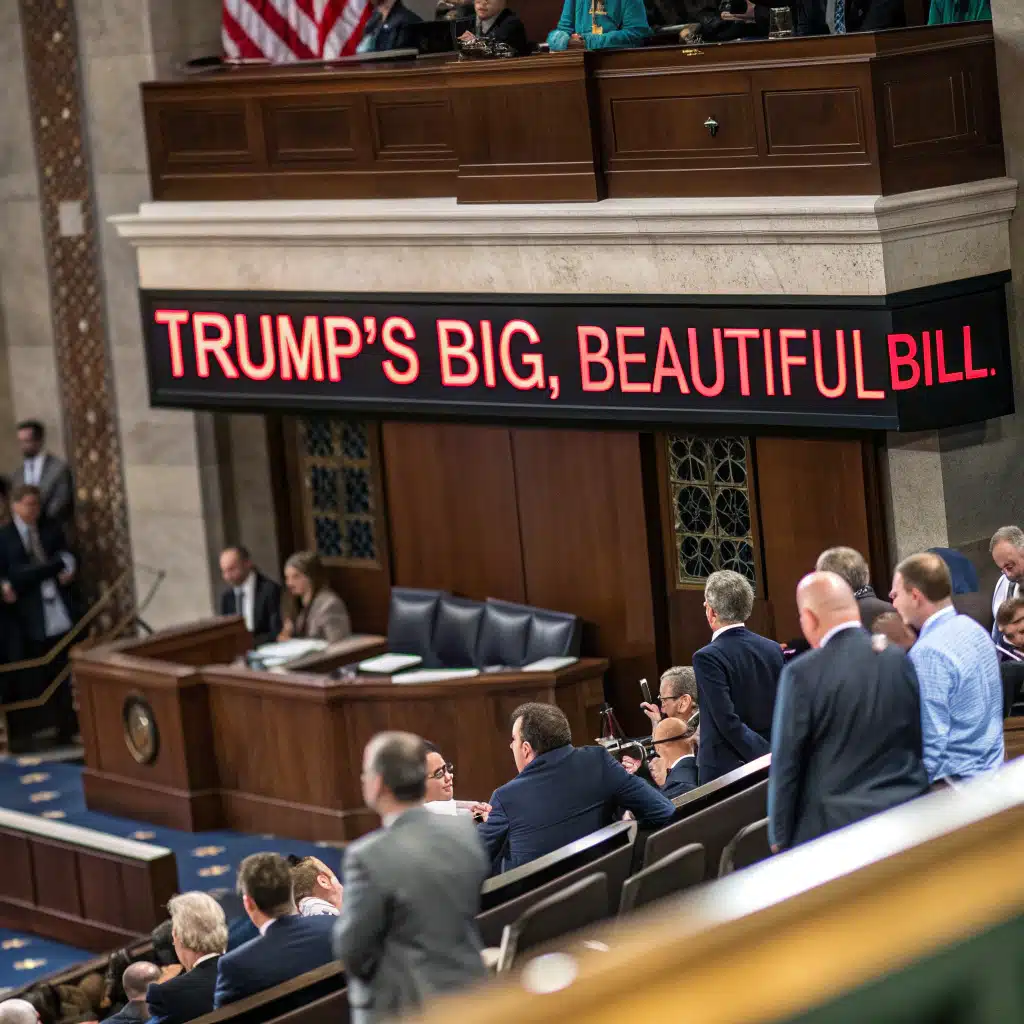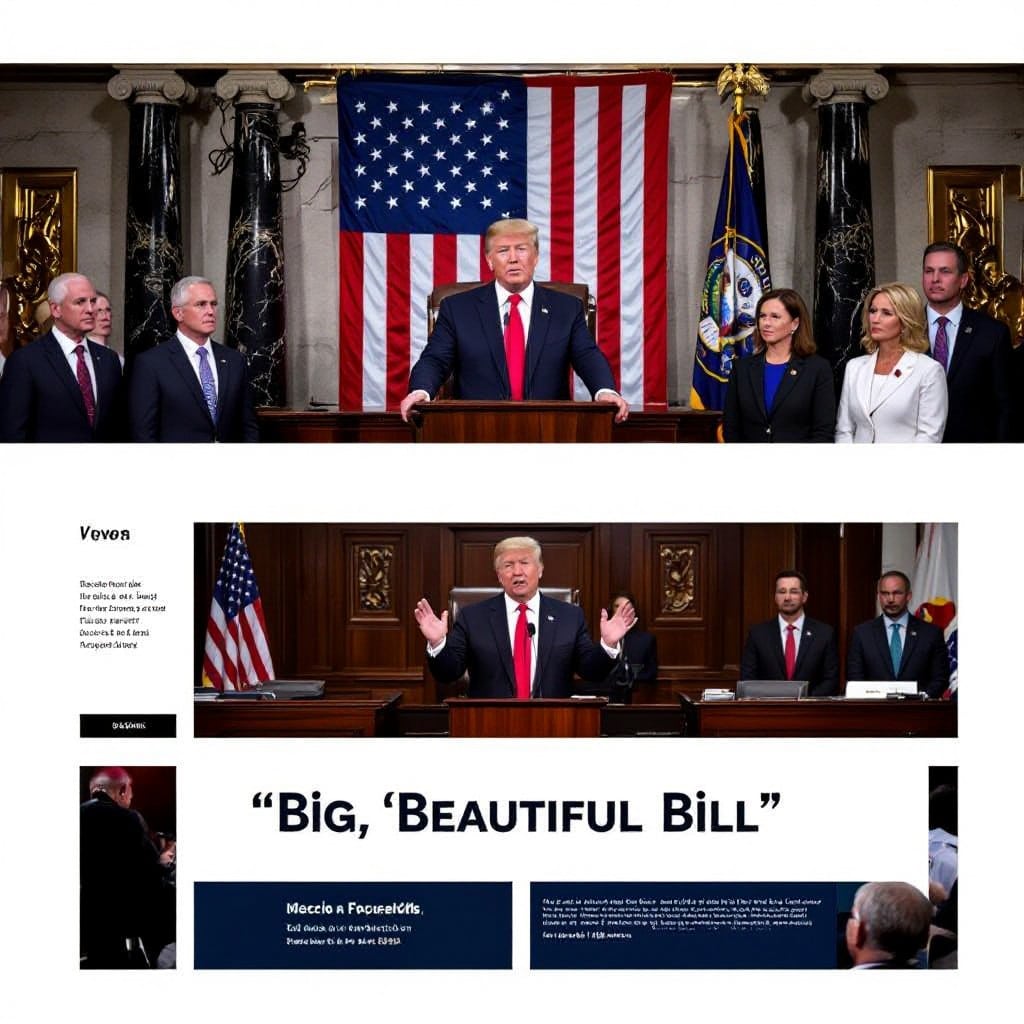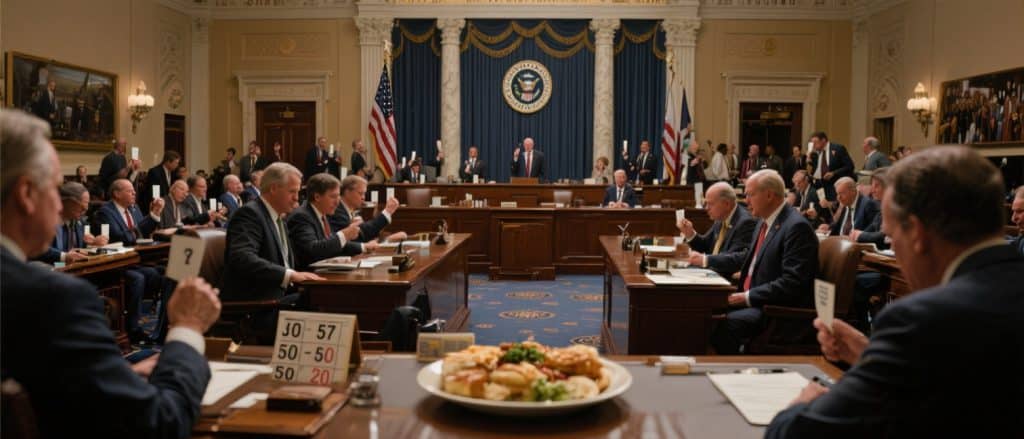Senate lawmakers are engaged in a marathon vote-a-rama that could shape the future of President Trump’s expansive domestic policy bill. As you follow this hourslong session, be aware that the legislation includes historic Medicaid cuts affecting millions and tax changes projected to increase the deficit by trillions. Your attention to these developments is key, as the debate reflects deep divisions and sets the stage for significant impacts on health care, taxes, and government spending that may affect you and your community.
Inside the Vote-a-Rama: A Glimpse into the Process
You’re witnessing a highly unusual legislative marathon that stretches the Senate into uncharted procedural territory. The vote-a-rama’s hallmark is its relentless pace — an open-ended, hourslong series of offerings and roll-call votes on amendments to the bill. Lawmakers can propose an almost unlimited number of amendments, ranging from deeply substantive changes to politically charged gestures. This flood of votes tests both the stamina and strategic agility of senators as they fend off last-minute attempts to alter the bill or exploit vulnerabilities for political gain.
The dynamic environment turns each vote into a potential pivot point, allowing senators to signal positions to their constituents or rally support among colleagues. The seemingly chaotic process actually reflects a controlled institutional mechanism crafted to wring out every possible tweak before final passage. You’re importantly watching the Senate’s version of a legislative pressure cooker, with hours ticking down to an uncertain conclusion.
The Mechanics of the Vote-a-Rama
The vote-a-rama officially began early Monday morning around 9:35 a.m. and extended past midnight, an extraordinary duration indicative of the volume and complexity of proposed amendments. Once started, senators take turns submitting amendments one after another, each followed by a quick vote. The session has no set end time — it continues until no further amendments remain or until Senate leaders call it to a close. Behind the scenes, clerks struggle with nonstop roll calls, and senators balance the competing demands of speed and scrutiny.
While votes often proceed swiftly, some moments escalate into drawn-out debates, especially on amendments touching Medicaid and tax provisions. For example, GOP Sen. Susan Collins’s amendment aiming to boost funding for rural health care faced a procedural vote rather than a direct up-or-down decision, highlighting how procedural maneuvers shape outcomes. Procedural votes can effectively kill amendments without further debate, allowing leadership to manage the pileup of changes amidst pressing deadlines.
Key Political Strategies Employed
Strategically, the vote-a-rama serves as a high-stakes arena where both parties flex political muscle. Republicans leverage the process to fine-tune the bill’s language, address internal fractures like those from Sen. Lisa Murkowski’s crossover votes on Medicaid and SNAP, and demonstrate responsiveness to various constituencies. Democrats, conversely, capitalize on the marathon to spotlight GOP proposals they deem harmful, especially historic Medicaid cuts and tax giveaways, pushing opposing amendments that often fail but produce a political record.

By watching how senators manage amendment introductions, procedural votes, and voting alignments, you gain insight into the broader power dynamics at play — who holds sway, where fractures in party unity lie, and how lawmakers navigate the tightrope between governing and campaigning in this drawn-out legislative battle.
Historical Context: The Stakes of Trump’s Policy Bill
The magnitude of Trump’s domestic policy bill is underscored by its ambitious scale and far-reaching consequences. You’re looking at a package designed to reshape the nation’s fiscal priorities, redirecting trillions of dollars through expansive tax cuts while simultaneously making deep reductions to social safety nets. This bill isn’t just another legislative effort; it represents a fundamental shift in how federal resources are allocated, directly affecting millions of Americans’ access to health care and social support.
Projections from the Congressional Budget Office reveal the stakes clearly—by 2034, the Senate’s version would leave nearly 11.8 million more Americans uninsured, worsening coverage even beyond the House’s version. Beyond coverage numbers, the legislation introduces unprecedented requirements and funding caps that could alter Medicaid’s core structure. Your understanding of these changes highlights why this bill is among the most significant domestic policy measures in recent decades, especially in terms of health care and budgetary priorities.
Major Changes Proposed in Domestic Policy
The bill’s centerpiece lies in its historic cuts to Medicaid, which funds care for over 71 million low-income and vulnerable Americans. You should note that the Senate’s proposal would slash federal Medicaid support by a staggering $930 billion over ten years, exceeding even the House’s $800 billion cut. Additionally, for the first time in Medicaid’s 60-year history, able-bodied adults between 19 and 64 would face enforceable work requirements to maintain benefits—a change with major implications for coverage continuity.
Other key provisions include modifications to state provider taxes; the Senate bill lowers caps but simultaneously raises reimbursement rates for providers in states that expanded Medicaid, applying only to 40 states plus D.C. Meanwhile, the House opts for a moratorium on existing provider taxes. Tax policy changes drive the bill’s fiscal calculations as well, with permanent extensions of corporate tax breaks from the 2017 law and mildly softened reductions to programs like SNAP, all contributing to an increased deficit projection nearing $3.3 trillion over the next decade.
The Political Landscape Surrounding the Bill
The legislative terrain around this bill is complex and fractious. You see fissures within the Republican Party as some senators cross party lines to support amendments, especially on contentious Medicaid and rural hospital provisions, signaling deep reservations despite official backing. Alaska’s Sen. Lisa Murkowski and Maine’s Sen. Susan Collins exemplify this tension, pushing for health care funding measures that ultimately failed but highlight internal GOP debates on balancing fiscal conservatism with constituent needs.
Democrats have strategically targeted Medicaid and other safety-net cuts as focal points of opposition, exploiting the extended vote-a-rama to spotlight weaknesses and force politically difficult votes. The timeframe itself adds pressure: with a White House demand to deliver the bill by July Fourth, and unsettled support in the House under Speaker Mike Johnson, the political stakes for lawmakers are overwhelmingly high, leaving your elected representatives navigating a volatile mix of ideological priorities and electoral calculations.
The dynamic between chamber-specific versions of the bill and their differing provisions further complicates the legislative path. You’ll witness ongoing negotiations not just between parties, but within them, as conservative Democrats and moderate Republicans weigh the social and economic implications alongside political survival, creating a deeply polarized yet delicate balancing act that will ultimately shape whether this transformative legislation passes and what its final form will be.
Medicaid and Its Transformational Cuts
The Senate’s version of the bill proposes a staggering $930 billion reduction in federal Medicaid funding over the next decade, surpassing the House’s estimated $800 billion cut. This scale of reduction signals a radical restructuring of the program that has provided a lifeline to over 71 million Americans. One of the notable changes includes the imposition of work requirements on able-bodied adults aged 19 to 64—a policy shift marking the first time in Medicaid’s 60-year history that beneficiaries must meet such conditions to retain coverage. The Senate takes the policy further by extending work requirements to parents of children aged 14 and older, unlike the House bill which exempts parents altogether.
Another controversial Medicaid-related provision reduces the cap on taxes states can levy on health care providers, a key funding source for the program. While the Senate version includes an increase in reimbursement rates for providers, these adjustments would only apply to the 40 states plus D.C. that expanded Medicaid under the Affordable Care Act. In contrast, the House bill imposes a moratorium on existing provider taxes for all states, raising concerns about the stability of rural and safety-net hospitals. Throughout the vote-a-rama, proposals aimed at bolstering rural health care — including amendments backed by Republican Senators Lisa Murkowski and Susan Collins — failed to gain traction, underscoring deep divisions even within GOP ranks.
Analysis of Medicaid Provision Changes
The proposed Medicaid reforms aren’t simply budget cuts; they represent a dramatic policy shift with complex fiscal and social repercussions. Reducing federal support by nearly a trillion dollars forces states to either cut benefits, tighten eligibility, or raise state funding to compensate. The Senate’s decision to apply work requirements to parents of older children uniquely targets a demographic that traditionally faces barriers such as childcare availability and unstable employment. This move could disproportionately increase disenrollment within families, raising the ranks of uninsured children and adults alike.

Implications for Vulnerable Populations
These historic cuts and policy changes will ripple profoundly through vulnerable communities—low-income families, seniors, people with disabilities, and millions of others who depend on Medicaid for crucial health services. Estimates from the Congressional Budget Office suggest that the Senate bill could leave 11.8 million more people uninsured by 2034, illustrating the wide-reaching human impact beyond fiscal numbers. The new work requirements threaten to disenfranchise individuals struggling with job access issues, while reductions in provider taxes and funding may lead hospitals, particularly in underserved areas, to reduce services or close altogether.
Communities already grappling with inadequate healthcare resources stand to face greater barriers, potentially reversing gains achieved over decades. The strain on rural hospitals could cascade into broader public health challenges, like increased emergency room use and untreated chronic illnesses, which in turn compound costs across the healthcare system. Your access to care, particularly if you live in a Medicaid-expanded state or depend on safety-net providers, may become more precarious as these provisions take effect.
Fiscal Impact: Understanding the Deficit Expansion
The Senate’s approach to scoring the bill’s fiscal impact diverges sharply from the traditional method, with Republicans advocating for the “current policy baseline.” This alternative method excludes the cost of extending expiring 2017 tax provisions, which effectively understates the increase in the federal deficit. According to the Congressional Budget Office using its standard “current law baseline,” the Senate bill is projected to add a staggering $3.3 trillion to the deficit over ten years—substantially more than the House version. You should note this significant escalation is driven largely by the bill’s permanent extensions of tax breaks from the 2017 tax law and a softer stance on spending cuts and revenue raisers.
By contrast, under the Republicans’ preferred scoring, the cost shrinks dramatically to about $508 billion over a decade. This discrepancy highlights how baseline assumptions can influence deficit estimates and potentially set a precedent for future tax legislation costing calculations. The bill’s expansion of corporate tax breaks and more modest reductions to programs like food stamps reflect a political balancing act but come at the price of higher federal borrowing and debt growth down the line.
Comparing Senate and House Provisions
| Senate Bill | House Bill |
|---|---|
| Projected to add $3.3 trillion to the deficit over 10 years (traditional baseline) | Projected to add less than Senate, with about $800 billion less in Medicaid cuts |
| Makes permanent three corporate tax breaks from 2017 law | Does not fully extend all 2017 corporate tax provisions |
| Less aggressive spending cuts, especially in food stamp program | Implements deeper cuts to food stamp benefits |
| Medicaid cuts total $930 billion over 10 years, with work requirements expanded to parents of children 14+ | Medicaid cuts near $800 billion, exempts parents from work requirements |
| Caps state provider taxes, modifies reimbursement rates (applies to Medicaid expansion states) | Moratorium on existing provider taxes |
The Senate’s more expansive tax cuts and shallower spending reductions contrast with the House’s tighter fiscal restraint in some areas, though both chambers aim for historic Medicaid spending cuts. These differences reinforce the challenge ahead: your elected officials must reconcile competing fiscal ideologies before the bill reaches the president’s desk, while balancing deficit impacts with political appetites.
Potential Long-term Economic Consequences
The large deficit increase projected by the Senate bill could intensify pressure on future budgets, forcing difficult trade-offs or driving up borrowing costs. Sustained federal deficits near the trillions raise concerns about crowding out private investment and slowing economic growth. Medicaid cuts—particularly the expanded work requirements and reduced federal support—may reduce healthcare access for millions, negatively impacting public health and economic productivity in vulnerable communities.
Moreover, permanently extending corporate tax breaks could disproportionately benefit high earners and corporations without delivering corresponding economic stimulus. The scaling back of certain safety-net programs further risks widening inequality and increasing financial insecurity for lower-income families, potentially slowing consumer spending which underpins much of the economy. These dynamics underline significant risks embedded within the bill’s design that you should consider as the legislative process unfolds.
Political Ramifications: The Impact on Campaigns
How Voting on Amendments Influences Future Elections
The marathon vote-a-rama offers a rare window into senators’ stances on contentious issues just weeks before crucial midterm elections. Each amendment vote becomes a tangible record that can be weaponized by opponents or leveraged by supporters. For instance, Sen. Lisa Murkowski’s decision to back Democratic amendments on Medicaid and SNAP was widely seen as a risky cross-party move that could alienate conservative voters in Alaska, potentially inviting a primary challenge or energizing opposition campaigns. Conversely, GOP senators opposing major cuts may face backlash from the party’s base, complicating their reelection bids in swing states.
Beyond individual implications, the cumulative effect of these votes shapes broader party narratives about fiscal responsibility, healthcare, and social safety nets. Amendments that fail or barely pass ignite intense messaging battles. Democrats can highlight GOP divisions and paint the bill’s harsh Medicaid cuts as harmful, while Republicans emphasize tax cuts and border security funding as achievements. Your vote today might be scrutinized relentlessly in campaign ads, debates, and town halls, creating ongoing political pressure to balance governance and electoral survival.
The Role of Public Sentiment and Media Coverage
Media outlets and public opinion will amplify the consequences of this prolonged voting session. The length and contentiousness of the vote-a-rama ensure that every high-profile vote receives extensive coverage, providing a steady stream of soundbites and headlines that shape voter perceptions. Journalists scrutinize amendments affecting vulnerable populations, underscoring the projected 11.8 million increase in uninsured Americans under the Senate version. This framing fuels public debates on Medicaid cuts, putting senators’ decisions under a microscope and influencing approval ratings.
Social media further accelerates the spread of narratives created during the vote-a-rama, with viral posts and targeted ads leveraging moments of defection or partisan unity. Senators like Susan Collins, who faced criticism from both sides after her amendment failed, may find themselves at the center of grassroots campaigns and media speculation. The relentless news cycle means that public sentiment often crystallizes quickly, impacting not just re-election prospects but also internal party dynamics as leaders gauge who can withstand backlash.
Expect coverage to focus heavily on the human stories behind the Medicaid cuts and deficit increases, highlighting families and communities that stand to lose coverage or face higher costs. Such narrative-driven reporting heightens emotional responses and mobilizes advocacy groups, which can translate into intensified voter turnout or pressure on lawmakers to adjust their positions before final passage.
To wrap up
The marathon vote-a-rama underway in the Senate on President Trump’s expansive domestic policy bill exemplifies the intense legislative process at play. As you follow these extended sessions, you witness the complex negotiations and strategic maneuvers by both Republicans and Democrats, each seeking to influence the bill’s final shape. This ongoing vote-a-rama not only highlights the divisions within parties—particularly over Medicaid and health care—but also sets the stage for the political battles ahead, influencing the legislative outcome and campaign narratives.
The stakes are high, with historic cuts to Medicaid and significant tax adjustments poised to affect millions of Americans. Your understanding of these developments will deepen as the bill moves through intricate voting procedures and potential revisions. With the timeline tightening and uncertainty in the House, you can expect this legislative process to continue unfolding with far-reaching implications for federal spending, social programs, and the national deficit.
FAQ
Q: What is the purpose of the ongoing vote-a-rama in the Senate regarding President Trump’s domestic policy bill?
A: The vote-a-rama is an extended series of votes on various amendments to the bill, which allows Republicans to make last-minute changes and Democrats to challenge specific provisions. This marathon voting session provides a platform for both parties to address political and substantive issues in the bill before a final vote is taken.
Q: How do the Medicaid provisions in the Senate version of the bill differ from those in the House version?
A: The Senate version proposes deeper cuts to Medicaid, potentially leaving 11.8 million more people without health insurance by 2034, compared to 10.9 million under the House bill. Both versions impose work requirements on certain Medicaid recipients for the first time in the program’s history, but the Senate applies the requirement to parents of children ages 14 and older, while the House exempts parents of dependent children. The Senate bill also adjusts provider taxes and reimbursement rates differently, targeting states that expanded Medicaid.
Q: What impact will the Senate bill have on the federal deficit according to the Congressional Budget Office (CBO)?
A: The CBO projects that the Senate’s bill will increase the federal deficit by nearly $3.3 trillion over ten years using the traditional current law baseline scoring method. This cost is higher than the House bill’s estimated impact due to larger tax cuts and smaller spending cuts. However, when using the alternative current policy baseline preferred by some GOP leaders, the Senate bill’s cost appears lower, at roughly $508 billion over the next decade.

